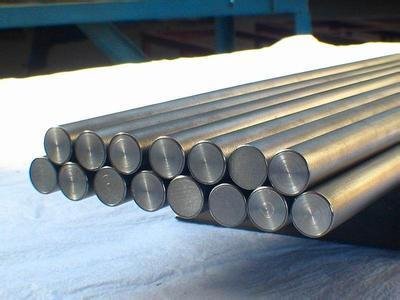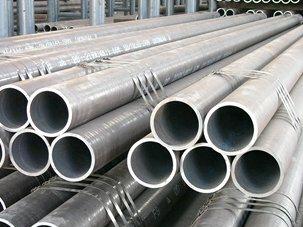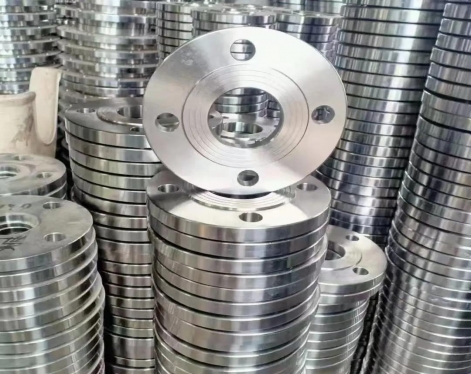Round steel refers to a solid strip of steel with a circular cross section. Its specifications are expressed in diameter, in millimeters (mm), such as "50mm" means a round steel with a diameter of 50 mm.Round steel is divided into three types: hot rolled, forged and cold drawn. The specifications of hot-rolled round steel are 5.5-250mm. Among them: 5.5-25 mm small round steel is mostly supplied in bundles of straight strips, and is often used as steel bars, bolts and various mechanical parts. Round steel larger than 25 mm is mainly used for the manufacture of mechanical parts, seamless steel pipe blanks, etc.
Carbon steel can be divided into low carbon steel, medium carbon steel and high carbon steel according to chemical composition (that is, carbon content).
1. Low carbon steel
Also known as mild steel, the carbon content is from 0.10% to 0.30%. Low carbon steel is easy to accept various processing such as forging, welding and cutting, and is often used to make chains, rivets, bolts, shafts, etc.
2. Medium carbon steel
Carbon steel with a carbon content of 0.25%~0.60%. There are killed steel, semi-killed steel, boiling steel and other products. In addition to carbon, it can also contain a small amount of manganese (0.70%~1.20%). According to product quality, it is divided into ordinary carbon structural steel and high-quality carbon structural steel. Good thermal processing and cutting performance, poor welding performance. The strength and hardness are higher than low carbon steel, but the plasticity and toughness are lower than low carbon steel. Hot-rolled and cold-drawn materials can be used directly without heat treatment, or after heat treatment. Medium carbon steel after quenching and tempering has good comprehensive mechanical properties. The highest hardness that can be achieved is about HRC55 (HB538), and σb is 600~1100MPa. Therefore, in various uses of medium strength level, medium carbon steel is the most widely used. In addition to being used as building materials, it is also widely used in the manufacture of various mechanical parts.
3. High carbon steel
Often called tool steel, the carbon content is from 0.60% to 1.70%, and it can be hardened and tempered. Hammers, crowbars, etc. are made of steel with a carbon content of 0.75%; cutting tools such as drills, taps, reamers, etc. are made of steel with a carbon content of 0.90% to 1.00%.


The difference between round steel and other steel bars:
1. The appearance is different. The shape of the round steel is smooth and round, without lines and ribs, and the surface of other steel bars has grooves or ribs, so that the bonding force between the round steel and concrete is small, while the bonding force between other steel bars and concrete is large.
2. The ingredients are different. Round steel (grade one steel) belongs to ordinary low carbon steel, and other steel bars are mostly alloy steel.
3. The intensity is different. The strength of round steel is low, while the strength of other steel is high, that is, compared with other steel bars, round steel with the same diameter can bear less tensile force than other steel bars, but the plasticity of round steel is stronger than other steel bars. That is, the round steel bar has a large deformation before being broken, while the deformation of other steel bars is much smaller before being broken.
The difference between round steel and seamless pipe:
Seamless steel pipes have a hollow cross-section and are widely used as pipes for transporting fluids, such as pipes for transporting oil, natural gas, gas, water, and certain solid materials. Compared with solid steel such as round steel, seamless steel pipe has a lighter weight when it has the same flexural and torsional strength, and is an economical cross-section steel. Widely used in various departments such as petroleum, chemical industry, boiler, power station, ship, machinery manufacturing, automobile, aviation, aerospace, energy, geology, construction and military industry.
Carbon steel can be divided into low carbon steel, medium carbon steel and high carbon steel according to chemical composition (that is, carbon content).
1. Low carbon steel
Also known as mild steel, the carbon content is from 0.10% to 0.30%. Low carbon steel is easy to accept various processing such as forging, welding and cutting, and is often used to make chains, rivets, bolts, shafts, etc.
2. Medium carbon steel
Carbon steel with a carbon content of 0.25%~0.60%. There are killed steel, semi-killed steel, boiling steel and other products. In addition to carbon, it can also contain a small amount of manganese (0.70%~1.20%). According to product quality, it is divided into ordinary carbon structural steel and high-quality carbon structural steel. Good thermal processing and cutting performance, poor welding performance. The strength and hardness are higher than low carbon steel, but the plasticity and toughness are lower than low carbon steel. Hot-rolled and cold-drawn materials can be used directly without heat treatment, or after heat treatment. Medium carbon steel after quenching and tempering has good comprehensive mechanical properties. The highest hardness that can be achieved is about HRC55 (HB538), and σb is 600~1100MPa. Therefore, in various uses of medium strength level, medium carbon steel is the most widely used. In addition to being used as building materials, it is also widely used in the manufacture of various mechanical parts.
3. High carbon steel
Often called tool steel, the carbon content is from 0.60% to 1.70%, and it can be hardened and tempered. Hammers, crowbars, etc. are made of steel with a carbon content of 0.75%; cutting tools such as drills, taps, reamers, etc. are made of steel with a carbon content of 0.90% to 1.00%.


The difference between round steel and other steel bars:
1. The appearance is different. The shape of the round steel is smooth and round, without lines and ribs, and the surface of other steel bars has grooves or ribs, so that the bonding force between the round steel and concrete is small, while the bonding force between other steel bars and concrete is large.
2. The ingredients are different. Round steel (grade one steel) belongs to ordinary low carbon steel, and other steel bars are mostly alloy steel.
3. The intensity is different. The strength of round steel is low, while the strength of other steel is high, that is, compared with other steel bars, round steel with the same diameter can bear less tensile force than other steel bars, but the plasticity of round steel is stronger than other steel bars. That is, the round steel bar has a large deformation before being broken, while the deformation of other steel bars is much smaller before being broken.
The difference between round steel and seamless pipe:
Seamless steel pipes have a hollow cross-section and are widely used as pipes for transporting fluids, such as pipes for transporting oil, natural gas, gas, water, and certain solid materials. Compared with solid steel such as round steel, seamless steel pipe has a lighter weight when it has the same flexural and torsional strength, and is an economical cross-section steel. Widely used in various departments such as petroleum, chemical industry, boiler, power station, ship, machinery manufacturing, automobile, aviation, aerospace, energy, geology, construction and military industry.









